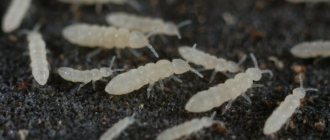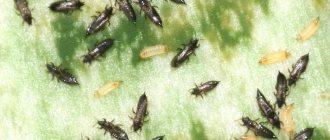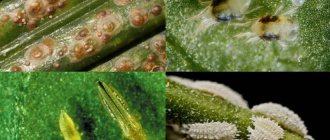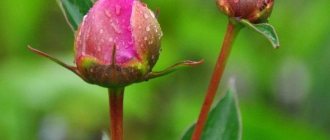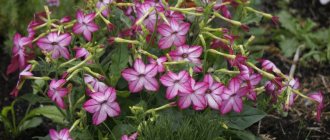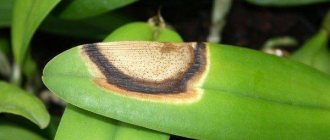Of course, houseplants are less vulnerable to disease and pests than their garden counterparts because they are usually under stricter control. But if houseplants are attacked or damaged by insects, they are more difficult to treat because green plants are more rotten, more tender, and less responsive to outside interference, especially the use of chemicals.
The wrong location (too dark, too sunny, too cold, too warm, low humidity) and improper care (too much water, too little water, wrong fertilizer, wrong substrate) can contribute to poor plant health. Poor care also contributes to the fact that pests and diseases affect indoor flowers, plants refuse to bloom, wither and eventually die.
Know your enemies by sight. Therefore, check out the photos and names of houseplant diseases and pests, causes and how to get rid of these insects and infections.
Powdery mildew
Powdery mildew
It is provoked by ectoparasitic fungi, which, when they get on a leaf, multiply quite quickly and increase the affected area. It appears in the form of a white persistent coating, which is located on the leaf part and on the fruit. The disease itself is practically harmless. Its consequences are dangerous. A long-term fungal infection significantly weakens the immune system, which makes it possible for a secondary disease to occur.
Often, against the background of powdery mildew, rot and other fungal infections form. Roses, pumpkin plants, and Rosaceae are susceptible to the disease. Among indoor flowers - ficus. To prevent the development of fungus, it is necessary to carry out preventive spraying with antifungal drugs: Fundazol, Vitaros, Topaz.
The most effective ways to combat powdery mildew without chemicals are spraying with baking soda. To do this, stir 1 teaspoon of soda in a glass of warm water and spray it throughout the plant through a spray bottle. To improve adhesion, you can add half a teaspoon of liquid soap (tar tar is best). Powdery mildew will not appear on roses if spraying is done 2 times a month starting in April.
Downy mildew
Downy mildew
The disease is provoked by the same fungi, but the distinguishing feature is the location of the mold. A thick white coating forms on the inside of the leaf, which may not be visually noticed for a long time. As the fungal infection grows and develops, orange spots form on the surface of the leaf blade, which lead to curling of the leaf, but do not cause them to fall off.
In the fight, the remedy Fundazol has proven itself well, which is used for crops of any kind, including trees. Most often, those specimens that get sick are those that are watered with cold water.
Yellow leaf virus
It often affects tomatoes and cucumbers, but with high humidity it can also occur on potato tops. The yellow curl virus causes plant leaves to quickly curl, making the full process of photosynthesis impossible.
Yellow leaf virus
How did the infection occur? With high soil humidity and elevated temperatures, this is an ideal environment for the virus to multiply. A secondary reason is the lack of fertilizing and disinfection of the soil. Often plants get sick in greenhouses and greenhouses.
How does it manifest? The leaf begins to curl along the edge, forming a kind of curl. Due to impaired photosynthesis, the color of the entire plant changes and the rich green tint disappears.
How to help? Unfortunately, it is pointless to treat such a virus, as it quickly spreads throughout the plant. Usually it is removed from the planting site along with the root, and the soil is treated with a weak solution of manganese. It can also be used to treat nearby plants.
Scab
Elena Stanislavskaya
I know everything and a little more about ornamental plants. I bring everything new and most interesting to life, creating unique landscape compositions and green oases in the house.
Ask a Question
This disease has collective symptoms and has its own pathogens for each plant species. It appears in the form of growths, tubercles or dents on fruits and trunks, which lead to deformation. Most often, potatoes, apples, pears, tomatoes, eggplants, peppers, and rosaceae are affected.
Scab
In the fight against scab, it is important to recognize it in a timely manner. If the slightest signs appear in the form of growths, preventive spraying should be carried out. You can choose a store-bought remedy for scab, which has a complex effect on the plant and prevents relapse. The available and safe options for combating the disease include the following:
- Spraying with mustard and ash - for 1 liter of hot water, take 1 tablespoon of mustard powder and 2 tablespoons of wood ash. Leave to brew for a day, then mix well and spray the entire above-ground part of the plant. The frequency of prevention is 4 times per season;
- Potassium permanganate and boric acid - for 1 liter of hot water, take no more than a match head of potassium permanganate powder and the same amount of boric acid powder. The result is a saturated purple solution, which is poured into a five-liter bucket, 1 tablespoon of iodine is added and flowers, shrubs and fruit trees are treated.
Scab treatment in spring is especially necessary for garden crops. Trees and shrubs should be sprayed with boiling water with the addition of 1 tablespoon of table salt per liter of water.
Ascochyta blight
Ascochyta blight
The disease is caused by the activity of fungi of the genus Askochita, which are found in large quantities in the soil. It appears in cereals, pumpkins and even citrus fruits. As for flowers, asters and chrysanthemums are most honored by fungi. The reasons for the development are:
- waterlogging of the soil (improper watering, prolonged downpours);
- excess nitrogen in the soil;
- sudden changes in temperature;
- dense plantings.
Ascochyta blight manifests itself in the form of fading of part of the leaf blade (like a sunburn), which quickly spreads to other areas. A completely affected flower dries out, and characteristic rot is present on the roots.
If the disease has affected most of the plant, then, no matter how sad it may sound, you will have to get rid of it. Ascochyta leaves are removed, and spraying with fungicides is used to prevent the entire flower from wilting. The means at hand are practically powerless, so preference is given to Bordeaux mixture and Topaz.
Advice! After the main etching, it is necessary to do preventive etching after 10-14 days. This way the result will be consolidated and the remnants of the mycelium will completely die, which will prevent the development of new foci of infection.
What is a "fungicide"?
First you need to figure out what it is. Fungicides are chemical preparations for treating plants and belong to a large group of pesticides. Translated from Latin, “fungicide” means “killing mushrooms.” They suppress the development and destroy fungi harmful to plants.
How fungicides work is still not known exactly. The vast majority of these drugs act directly on fungi and their spores, disrupting their normal life processes. Some fungicides disrupt the reproduction processes of fungi, some block the synthesis of proteins and other substances necessary for the life of the fungus, and some disrupt the normal process of fungal cell division.
Anthracnose
Anthracnose
Anthracnose is a group of fungal diseases that have different pathogens (imperfect fungi), but exhibit similarities in symptoms and course characteristics. Appears on orchids, garden and indoor plants, as well as shrubs and fruit trees. The causes of the disease are:
- excess nitrogen in the soil;
- increased alkalinity;
- deficiency of potassium and phosphorus;
- injuries to the green part of the leaf and the entry of fungal spores into the wounds.
Fungal bacteria in plants are spread by wind and insects, so if the first signs of anthracnose are present, treatment should be started immediately. The disease can be recognized by the following signs:
- spots on sheets that turn black over time;
- deformation of the leaf plate and stem;
- slowing down plant growth.
If appropriate measures are not taken in a timely manner, there is a risk of complete death of the plant, as well as the spread of bacteria to healthy crops growing in the immediate vicinity.
Treatment involves removing diseased leaves, as well as treating them with special fungicidal agents. Of the available options, anthracnose can be treated with Furacillin tablets. To do this, grind 2 tablets into powder and pour a glass of hot water. Mix well until completely dissolved, then spray the green part and spill the soil around it.
Other types of raid
Silvery plaque is not the only problem of the Crassula. There is also a white, yellowish and brown layer on the leaves, growths, drying and other ailments of the green mass of the flower.
Clarification:
- These phenomena should not be confused with changes in the color of tree leaves due to direct sunlight. The crown may turn brown from the sun, but when moving to another place, the situation will begin to change over time.
- Brown spots can indicate insufficient watering. As soon as the moisture regime returns to normal, the spots will disappear.
Plaque of any color is a symptom of serious problems. They assume that the tree will soon begin to wither and wither. The change in leaf color only signals the beginning of the process.
Try to react in time to the appearance of bad plaque on the money tree. Diseases develop very quickly, and pests can spread to other nearby flowers.
Septoria
Septoria
It is provoked by the activity of primitive fungi of the genus Septoria, which affect phlox, anthurium and many garden crops. The causes of the development of the disease are waterlogged soil and watering with cold water, which weakens the immune system and does not allow the plant to resist infection using the natural defenses of the plant.
Symptoms of the disease are small dark yellow spots, which over time spread along the leaf and lead to its drying out and natural falling. A characteristic feature is the pink iris that forms around the spots.
In treatment, only complex fungicidal preparations are used, since improvised means are ineffective in most cases.
Methods for controlling pests of indoor flowers
Tired of the eternal problems with indoor plants: mold, rot, leaf wilting, chlorosis, pests? It is easier to prevent any attack than to cure it. We will teach you to “read” the symptoms of plant diseases, recognize pests by sight, treat and prevent the most dangerous diseases of indoor and ornamental garden flowers.
What are the diseases of house flowers?
If you notice a strange spot or a dried leaf on a plant, you should figure out what you are dealing with. In addition to a banal deficiency of macro- and microelements or errors in care, the cause of this condition can be fungal, viral or bacterial infections, as well as pests.
Viral diseases
These infections are the most difficult to diagnose and treat, they are easily confused with various deficiency conditions and the consequences of illiterate care.
Viral infection weakens plants, making them limp, stunting development and deforming organs. If you remove the damaged parts at the very beginning of the disease and reconsider the care, the flower can be saved, but usually the plant continues to lose strength and slowly dies. Viruses are transmitted by sucking pests: spider mites, whiteflies, thrips, aphids. Mosaic disease
gives the leaves a characteristic pattern of light, yellowish spots appearing along the leaf veins. Over time, the affected area increases, and the entire leaf begins to resemble a bizarre mosaic.
mosaic disease
Infectious chlorosis
or jaundice begins with leaf discoloration, followed by necrosis - leaf tissues die, flower petals become discolored, and stems become brittle. Young shoots are the last to be affected.
Leaf curl
causes their deformation: swollen, wrinkled areas change the shape of the leaf, twisting it inward. Both garden and indoor crops suffer from curl.
Viruses affect : callas, hydrangeas, orchids, pelargoniums, primroses, begonias
Plant rust
Plant rust
Rust is caused by a large class of primitive fungi, the spores of which have a rich orange hue. Any garden crops are affected. In rare cases, the disease can manifest itself in representatives of indoor plants, which indicates improper feeding and lack of soil disinfection before planting.
Rust appears in the form of bulges on an orange leaf, upon contact with which pollen is released. Bacteria are spread by wind and insects, so experts recommend preventative treatments in the spring that will help prevent infection of all plants in the garden.
Plant rust
To combat the disease, spraying with Bordeaux mixture is used in early spring. When rust forms on indoor flowers, use appropriate fungicides.
Bacterial
The symptoms of bacterial diseases are similar to fungal diseases, which makes diagnosis difficult. However, the spots in this case have blurry contours, similar to oily, glassy ones. Infection can occur through mechanical damage, through tubers, or seeds. Pets and ourselves can become carriers of bacteria! Bacteria are invisible to the eye; they enter the soil, and from there into the vascular system of the flower.
Bacterial wet rot
Bacteria cause tissue breakdown - softening and rotting! Traces of their activity look like a damp, shapeless spot. Spots can appear on trunks, roots, tubers, bulbs, but more often on leaves. To the touch, parts of the plant become soft to the touch and gradually turn into a soggy, bad-smelling mass.
Risk group : bulbous and tuberous plants.
bacterial rot
Bacterial spot, fire blight
In this case, small watery spots appear along the veins of the leaf, gradually acquiring a black color; they may be surrounded by a yellow or brown border. Small or large, they look like a burn - as if the leaf in this place was charred! Spotting affects the upper young parts of the plant.
Risk group : dangerous for all plants, but most of all for bulbous and tuberous plants.
✿
Tracheomycosis wilt
It is provoked by fungi of the genus Fusarium and Verticillum. The disease is accompanied by the development of root rot, which in the shortest possible time leads to complete withering of the plant. The following factors provoke the development of wilting:
- Infection of the soil with purchased seedlings or infected seeds that have not undergone pre-sowing treatment;
- Excessive watering and rainy summers;
- Presence of other diseases.
Tracheomycosis wilt
Often tracheomycosis wilt develops as a secondary infection when the plant already has diseases that burden the immune system. Any crops and shrubs are at risk, but indoor violets, dollar trees, and orchids are most often susceptible to wilting.
In most cases, wilting cannot be stopped. The plant dies quite quickly. At the first signs of the disease, when apparently healthy leaves droop and lose their elasticity, treatment is carried out with a weak solution of potassium permanganate (soil and above-ground parts). Soda has proven itself to be good for fading. Its solution allows you to fight rot in the garden and on the windowsill.
We also have articles about viral and bacterial plant diseases.
Question to the expert
How to prevent diseases?
To prevent powdery mildew on indoor plants and other diseases of fungal and bacterial flora from causing harm, preventive treatment is recommended. The inhabitants of the window sill need to spray and spill the soil with water and hydrogen peroxide dissolved in it. This composition protects against many fungi, increasing plant immunity.
Soda has proven itself well in the garden. Spraying allows not only to destroy existing lesions, but also to prevent possible diseases. The garden is cultivated in early spring, after the leaves have been harvested. Repeated disinfection is performed after a month. If the weather is rainy, then spraying should be done once every 2 weeks.
Methods for controlling pests of indoor flowers
Half the battle is done - you have identified the pest and assessed the extent of the damage.
Now let's find out how to get rid of a dangerous neighbor and protect flowers? 1. First, try washing off the pests with water from the shower by wrapping the pot in a bag.
2. Treat the plant with a solution of green soap. Hurray! To the dacha! or the drug Kysh-Vestitel.
3. If too many plants in the garden are infected, you can use predatory insects: gall midges, parasites, which can be attracted by planting or sowing nectar-bearing plants - phacelia, tansy, dill, mustard, buckwheat and others. The fragrant umbels and bright yellow flowers attract flies, hoverflies, ladybugs and spiders.
4. In gardens with decorative flowers, hang bright yellow trapping plates; they will attract flying insect pests.
5. Use traditional methods: spray plants infected with mites with onion infusion or yarrow decoction.
